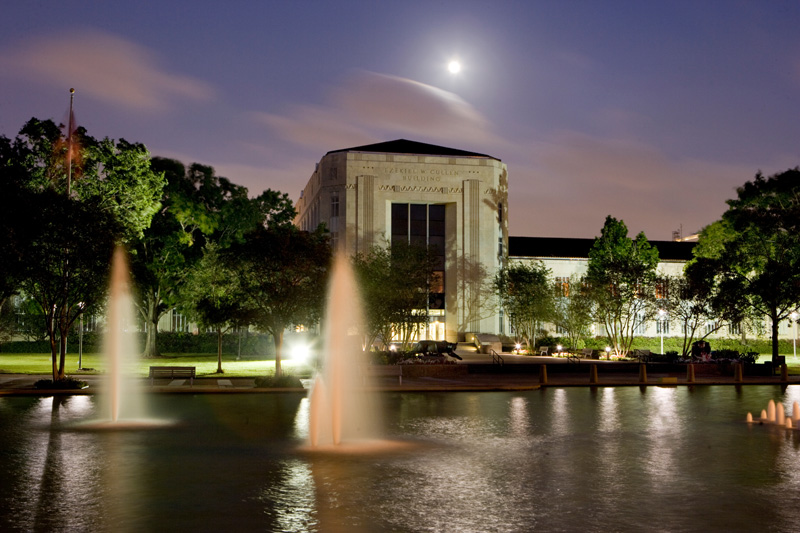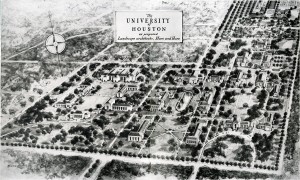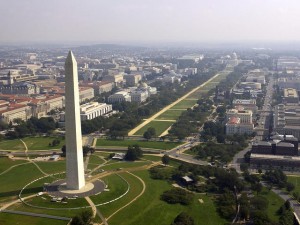
The following continues a series of contributions from Dr. Stephen James, who works with the Architecture and Planning collections here at the University of Houston Special Collections. Dr. James holds a Ph.D. in Architectural History from the University of Virginia and for many years was a lecturer at the University of Houston College of Architecture.
Our look at campus architecture today begins with Cullen Family Plaza, a favorite gathering place at the University of Houston. The plaza honors the Cullen family, whose patronage and leadership have shaped the university from its earliest days. Located in front of the Ezekiel Cullen Building, it is—along with the nearby Anne Butler Plaza in front of the M.D. Anderson Library—the social heart of the campus. Both plazas are relatively recent additions to the campus and resulted from a major overhaul of the university’s campus planning principles in the mid 1960s.
The campus was laid out in the 1930s by the Kansas City landscape architecture firm of Hare & Hare, which also designed Houston’s Hermann Park. Hare & Hare created a very formal, axial plan for the university, with the main buildings arranged in a rectilinear fashion and aligned symmetrically on either side of a centerline or axis. Several such axes can be seen in a 1930s rendering of the master plan from the Library’s Special Collections Department and in a 1967 aerial photograph from the UH Digital Library.
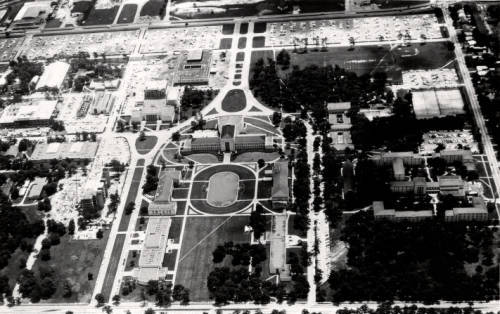
1967 aerial view shows UH buildings arranged around several formal axes, from the UH Photographs Collection and available for download in the Digital Library
This type of formal, axial planning, which dates back to ancient Rome, is used with monumental public buildings and is intended to convey a sense of grandeur or importance (think of the Mall in Washington, D.C.). The traditional architecture of the buildings represents the important public institutions housed within. Their predictable arrangement implies a reassuring sense of order, and their large scale makes the viewer seem insignificant in relation to these institutions. Formally, the spatial void in the center (the lawn or mall) is not meant to be inhabited; it reinforces the buildings that define it and helps tie the ensemble together.
The events of the 1960s changed public attitudes toward authority. Such formal planning became unpopular, as architects tried to humanize public institutions and make them less intimidating. Many campuses took on a “suburban” appearance by using more naturalistic landscape design and less rigid building placement.
These trends influenced the University of Houston, which abandoned its original master plan in 1966 to give the campus the casual, park-like character that it has today. Planners placed new buildings such as Farish Hall (1970), McElhinney Hall (1971), and Hoffman Hall (1974) across the important axes to create small plazas that might become centers of public activity in their own right, rather than simply reinforcing the importance of the buildings around them.
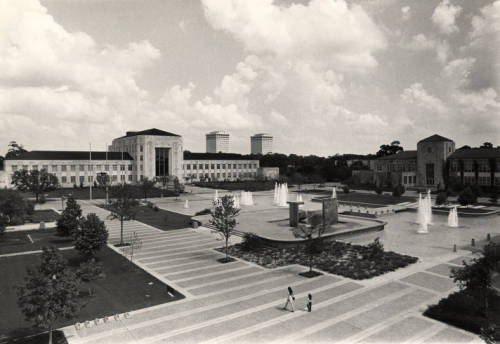
Cullen Family Plaza in the 1970s, shortly after its completion, from the UH Photographs Collection and available for download in the Digital Library
Cullen Family Plaza resulted from this change in 1972. Landscape architect Fred Buxton replaced the elliptical reflecting pool in front of E. Cullen with a large water pool that spanned the distance between the Roy Cullen and Science Buildings. Dramatic water jets introduced a dynamic element that balanced Lee Kelly’s large metal sculpture called “Waterfall, Stele, and River.” Farish Hall, completed shortly before the plaza, provided the necessary enclosure on the west side. In the four decades since, the landscaping has matured to soften the edges and further isolate the plaza from the distractions of the campus.
The UH Digital Library’s University of Houston Buildings Collection is an excellent resource for anyone looking for more information about the history of Cullen Family Plaza.
